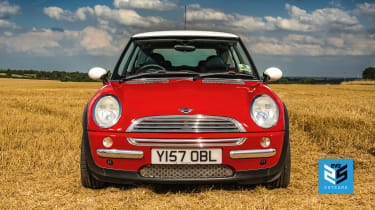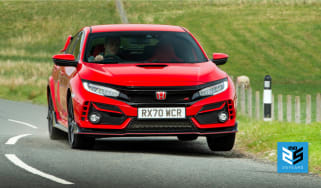Mini Cooper (R50) and Cooper S (R53): review, specs and buying guide
The R50 Mini Cooper captured all the fun of the original with excellent dynamics and a charming design, making it one of our top 25 cars of the last 25 years
BMW’s first Mini Cooper had big boots to fill, but then it also had bigger feet. Yes, the Mini hatchback that arrived in 2000 was a great deal bigger than the 41-year-old Rover-badged car it replaced, but it retained many of the original’s most appealing characteristics, from direct steering to an agile chassis and of course, retrospective styling.
In our 25th anniversary issue, the Mini wasn’t on my final five for the finest cars of the last 25 years. Or rather it was, but then I scratched it out because I feared I might be letting nostalgia elbow its way past rigorous objective journalism. You see, the R50 Mini Cooper was incredibly influential on me because I owned one for several years.
> The new Mini Cooper S is the last of its kind
RE51 DMO – red, white roof, Pepper pack, 15‑inch alloys, no air con – was my first proper evo car and I loved it. I bought it (three years before I joined the magazine) nearly new and when they were still a relatively rare sight on the roads, which meant it attracted a huge amount of attention. In fact, for £11,000 I had a supermini that was as eye-catching as a supercar, which was quite extraordinary. Not that attention-seeking was the reason I bought it. I wanted it because it had been lauded in these very pages.
Looking back at the three issues in 2001 in which it first featured, the praise it garnered was exceptional. John Barker’s summation after sampling it on the launch (issue 033): ‘There isn’t a higher quality, more distinctive and better value for money hatch on the market.’ David Vivian then elaborated when it was group-tested in the UK in the following issue: ‘It brings assets to the price point that are unprecedented: exceptional bodyshell integrity, genuine BMW build quality and finish, a dynamic signature unlike anything else currently available and, perhaps the neatest trick of all, pastiche styling that looks startlingly original.’
Now, you might have noticed that those extracts major on quality and value for money, but the driving came in for huge praise, too. In the same group test, Vivian went on to say this: ‘There is the kind of composure and precision that no other supermini has or ever had. Driving the new Mini is a truly new experience.’ Ultimately the 106 GTi emerged victorious in the battle for best pure, driving-on-the-limit thrills, but the Mini won the war because, as Viv wrote, ‘it makes you feel good every second you spend with it’.
What sealed the deal for me, however, was seeing the Mini (an evo subs desk decision was made early on not to follow BMW’s style guide and go all-caps MINI) in that year’s eCoty, duking it out in Tuscany alongside cars like the Vanquish, Zonda, and Murciélago. It wasn’t put in the shade, either, with Peter Tomalin writing ‘it feels special, even in Italy and even in this company’. In the end it finished 10th out of 12, which might sound a bit ho-hum. However, of the two cars it beat, one was the Clio 172, which was a huge scalp to take for a car like the Mini with just 113bhp.
The engine was never much to write home about but, as with most of the car, its slightly convoluted history makes its ultimate success all the more remarkable. When the new Mini was a Rover (the R in R50) project, a K-series was pencilled-in under the bonnet, but BMW switched this for a cheap, iron-block, 1.6-litre four-cylinder that was developed with Chrysler and built in Brazil. Much of the final work on the car, including the engine, was actually done by ex-Rover employees who had been moved to Ricardo when BMW sold the company.
The body was, of course, conceived by Frank Stephenson, with the help of car design’s most famous beer can (the exhaust tip was modelled on a can of Bud). I’d argue that today we are still seeing the ripples of the retro styling that was popularised with the R50. Would the Mk5 Golf GTI have brought back Mk1 nods like the golf ball gearknob and the tartan trim without the Mini? Possibly, because the New Beetle had been around since 1997, but I’d argue that the Mini did retro much more successfully. And the Beetle definitely can’t take any credit for pushing the Mk5 GTI to be better to drive.
The Mini also supercharged a new wave of personalisation in cars. The ability to have a Union flag on your roof, or to stand out with some stripes, was something a bit different at the time. It’s possible to argue that the phenomenal Porsche ‘paint to sample’ trend and the lucrative businesses that are MSO (McLaren), Ad Personam (Lamborghini) and Q (Aston Martin) all have Mini to thank for kickstarting the modern obsession with having something unique.
But while it might seem as if the Mini’s influence was mostly aesthetic, it also paved a much more performance-orientated way with the original John Cooper Works GP. Launched in 2006, it was unusually hardcore for a hot hatch at the time. Of most note was the removal of the rear seats – something we would later see in two of the greatest hatches ever, the 2008 Renault Sport Mégane R26.R and 2016 Volkswagen Golf GTI Clubsport S.
Would Jean-Pascal Dauce and his small team in Dieppe have got the nod for the R26.R from the suits above if BMW hadn’t done it first? Maybe not. In which case it couldn’t have appeared on my final five list. So perhaps I should have kept the Mini there after all.
Coopers started at £11,600 in 2001, while a less powerful and less expensive Mini One was also available, but the supercharged Cooper S (£14,500) was the car to bring even greater excitement to the Mini range, with 161bhp and a characterful whine from the supercharger.
Excitement was boosted further by official John Cooper Works versions of both cars. Unlike today’s JCW models, the early Works cars were actually developed at John Cooper Garages, run by John’s son Mike Cooper. There was old-school tuning involved, with a ported and polished cylinder head, and freer-flowing intake and exhaust systems to take power to 130bhp. Not a huge increase, but it made the Cooper more enthusiastic at higher revs and bumped up the fun factor accordingly. Available later, the Cooper S Works boasted 197bhp. The power kits weren’t cheap – £2408 fitted for the Cooper, £3010 for the S – but both were officially sanctioned by BMW.
2004 saw a facelift, while 2006 heralded the hardcore Mini John Cooper Works GP. The GP got a pair of Recaro seats up front, while the rear pews were discarded entirely in favour of a brace bar between the rear strut tops. There was less sound deadening material too, and claimed weight savings of 50kg compared to a standard Cooper S. Power climbed to 215bhp, and at 6.5sec to 62mph it was among the quickest hot hatches of the time.
Specs
| Cooper | Cooper S | Cooper S Works GP | |
| Engine | 1598cc, in-line 4cyl | 1598cc, in-line 4cyl, supercharged | 1598cc, in-line 4cyl, supercharged |
| Max power | 113bhp @ 6000rpm | 168bhp @ 6000rpm | 215bhp @ 7100rpm |
| Max torque | 110lb ft @ 4500rpm | 155bhp @ 4000rpm | 184lb ft @ 4600rpm |
| Weight | 1050kg | 1140kg | 1090kg |
| Power-to-weight | 109bhp/ton | 143bhp/ton | 200bhp/ton |
| 0-62mph | 9.2sec (claimed) | 7.2sec (claimed) | 6.5sec (claimed) |
| Top speed | 124mph (claimed) | 135mph (claimed) | 149mph (claimed) |
What we said
Mini Cooper, evo 033 (Jul 01), John Barker
‘It’s a pretty ordinary sounding engine, reasonably refined at tickover and tight and together up to 5000rpm. Throttle response is clean – if you didn’t know, you’d never guess it was drive-by-wire – but there’s not much edge to its low speed delivery… I’d be surprised if the Cooper cracked nine seconds to 60mph, and it would be a pretty raucous affair because at the top end the engine becomes rather thrashy.
‘It’s a shame the Cooper isn’t more gutsy because it’s every bit as chuckable and poised as you’d hope. It feels good the moment you pull away, with a solid, big-car feel and the encouraging sense that all the weight is concentrated below hip level. The Cooper rides rough sections with sporting suppleness, letting you feel connected but filtering out the sharp edges, and it flicks from camber to camber, apex to apex, with a precision and composure that inspires trust.’
Mini Cooper S, evo 043 (May 02), John Barker
‘With its considerable torque advantage, the Cooper S hauls through the lower gears with much more conviction, of course, but a close-ratio ‘box would surely have suited it better. Even so, BMW claims the S hits 62mph in 7.4sec and, to be honest, it feels good for it.
‘That’s the thing about the Cooper S: you expect more low-rev urgency, you think it should have shorter gearing, and yet at the end of a long day spent thrashing it up and down some great roads, you can’t help but conclude that it’s a superb little car that’s a whole heap more satisfying than the stock Cooper.
‘Steer into a turn and the S seems to pivot around a stake driven through the centre of the dashboard, biting into the road and slicing hard for the apex. There’s no obvious roll, no slip, the car just turns.’
Mini Cooper S Works GP, evo 094 (Aug 06), Jethro Bovingdon
‘At low speeds it’s familiar Mini: quick steering, strong torque, stiff, flat ride. Over ragged tarmac the GP shows some subtle differences. It’s still firm but somehow it feels more rounded, less likely to skip over sharp ridges and bounce the car off line. Sounds great, too. The 1.6-litre supercharged engine revs with all the intensity of a little screamer, but the strong torque means you don’t have to stir the sweet-shifting six-speed ‘box to make quick progress.
‘There’s a bit more roll than I’d expected, but that allows the 205/40 Dunlops’ treadblocks to lock into the surface and hook the nose into the apex. Jump on the power as you feel it settle and the standard limited-slip diff transmits all 218bhp to the road with immense composure, steering wheel gently writhing in your hands.’
What to pay
| Mini Cooper (R50) | Mini Cooper S (R53) | |
| Excellent | £7000 | £12,000 |
| Good | £4000 | £6000 |
| Average | £2800 | £4500 |
| Project | £800 | £1300 |








